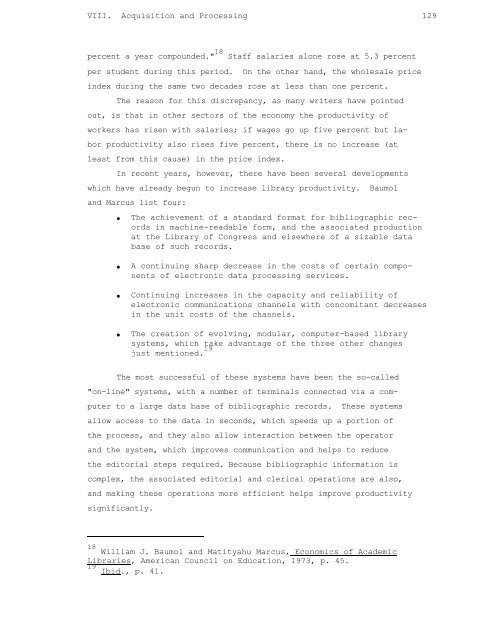The University of California Libraries: A Plan for Development (1977)
The University of California Libraries: A Plan for Development (1977)
The University of California Libraries: A Plan for Development (1977)
You also want an ePaper? Increase the reach of your titles
YUMPU automatically turns print PDFs into web optimized ePapers that Google loves.
VIII. Acquisition and Processing 129<br />
percent a year compounded." 18 Staff salaries alone rose at 5.3 percent<br />
per student during this period. On the other hand, the wholesale price<br />
index during the same two decades rose at less than one percent.<br />
<strong>The</strong> reason <strong>for</strong> this discrepancy, as many writers have pointed<br />
out, is that in other sectors <strong>of</strong> the economy the productivity <strong>of</strong><br />
workers has risen with salaries; if wages go up five percent but labor<br />
productivity also rises five percent, there is no increase (at<br />
least from this cause) in the price index.<br />
In recent years, however, there have been several developments<br />
which have already begun to increase library productivity. Baumol<br />
and Marcus list four:<br />
• <strong>The</strong> achievement <strong>of</strong> a standard <strong>for</strong>mat <strong>for</strong> bibliographic records<br />
in machine-readable <strong>for</strong>m, and the associated production<br />
at the Library <strong>of</strong> Congress and elsewhere <strong>of</strong> a sizable data<br />
base <strong>of</strong> such records.<br />
• A continuing sharp decrease in the costs <strong>of</strong> certain components<br />
<strong>of</strong> electronic data processing services.<br />
• Continuing increases in the capacity and reliability <strong>of</strong><br />
electronic communications channels with concomitant decreases<br />
in the unit costs <strong>of</strong> the channels.<br />
• <strong>The</strong> creation <strong>of</strong> evolving, modular, computer-based library<br />
systems, which take advantage <strong>of</strong> the three other changes<br />
just mentioned. 19<br />
<strong>The</strong> most successful <strong>of</strong> these systems have been the so-called<br />
"on-line" systems, with a number <strong>of</strong> terminals connected via a computer<br />
to a large data base <strong>of</strong> bibliographic records. <strong>The</strong>se systems<br />
allow access to the data in seconds, which speeds up a portion <strong>of</strong><br />
the process, and they also allow interaction between the operator<br />
and the system, which improves communication and helps to reduce<br />
the editorial steps required. Because bibliographic in<strong>for</strong>mation is<br />
complex, the associated editorial and clerical operations are also,<br />
and making these operations more efficient helps improve productivity<br />
significantly.<br />
18 William J. Baumol and Matityahu Marcus, Economics <strong>of</strong> Academic<br />
<strong>Libraries</strong>, American Council on Education, 1973, p. 45.<br />
19 Ibid., p. 41.
















